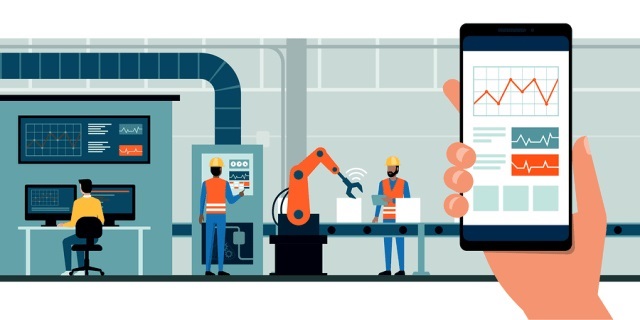10 Advantages of Monitoring Your Production Line in Manufacturing

Manufacturing production lines carry immense weight: they’re the means to creating anything from soaps to cars and medicines. But ensuring seamless and reliable production processes is vital to securing quality products. That’s why monitoring your production line is becoming an expectation for today’s manufacturers.
This blog will highlight ten advantages of monitoring your production line in manufacturing, ranging from improved efficiency to identifying issues quickly and even reducing costs. Taking the time to monitor your production line properly has the potential for a major payoff for non-stop operation and better quality output.
1. Increased Efficiency and Productivity
When you monitor your production line, you can track production metrics such as time taken for each task, number of units processed, and cycle times. You can then use the data you get from tracking to make better decisions about how to improve processes and increase output.
This kind of data-driven decision-making leads to quicker turnaround times in production and enhanced control over shelves, stocks, and resources. Utilizing the power of data collection can give you real-time insights into how production is performing, enabling you to identify inefficiencies quickly, resulting in increased output per worker on the line.
This efficient manufacturing method positively impacts the price of goods sold while simultaneously maximizing profits through higher-quality products produced.
2. Better Quality Assurance
Quality assurance is a key advantage of monitoring your production line in manufacturing, as the data collected can help to make necessary adjustments for a more efficient and productive workflow. For instance:
- Thermal cameras can measure temperature changes throughout the line, helping to identify overheated components that could be at risk for malfunction or breakdown.
- Machine vision systems are also beneficial, as they provide precise data on product throughput and accuracy that can give valuable insight into potential problems or areas which require additional improvement.
Quality assurance through better monitoring can not only maximize output but also minimize waste across your production processes – taking your business to the next level of productivity and success.
3. Reduced Waste, Labor, and Time
An Investment into tools such as production monitoring systems and digital manufacturing platforms can benefit your factory through reduced waste, labor, and time spent implementing the entire production management process. This can be achieved by using the following:
- Production line monitoring software and systems for line balancing optimization and high-speed filling line
- Automated machinery reduces human labor and increases efficiency as it takes care of routine processes more quickly and accurately.
- Sensors for collecting data on temperature, humidity, vibration, etc.
- Digital manufacturing platforms handle all aspects of engineering, planning, tracking, and maintaining inventory levels, meaning less manual input is required, saving precious labor and resources.
The combination of these smart tools can help to minimize costs by reducing waste, labor, and time spent in the manufacturing process – ultimately providing a great return on investment.
4. Improved Material Tracking
Having a monitoring system in place is essential for tracking material in manufacturing. It allows supervisors and managers to accurately trace the path of materials throughout the production line, so they can see where inventory items are being used, when they are available, and how long processes are taking.
Improved material tracking allows warehouse operations to be more organized and precise. Specific data on each item is recorded, allowing supervisors to easily account for every piece of material used in the manufacturing process. This information helps to:
- optimize production times
- creates more efficient inventory management practices
- and reduces the number of wasted resources due to improper distribution or usage.
Precisely monitoring through improved material tracking offers a range of advantages for modern warehouses and factories looking to cut costs.
5. Enhanced Employee Safety and Well-Being
Ensuring employee safety and feeling of well-being are key components of any successful manufacturing facility – and one way to ensure both are by implementing monitoring systems in the production line. Properly-monitored production lines help to:
- create a safe physical environment
- allow employers to identify potential dangers
- make corrections to mitigate those dangers and overall working conditions
- speed up response times for issues that arise on the floor
- provide clear documentation of the workday wellness for employees.
Overall, monitoring your production lines is an ideal way to easily gain an advantage in overall employee safety and welfare while giving your business a leg up in terms of productivity.
6. Prevent or Reduce Downtime
Monitoring your production line in manufacturing offers several outstanding advantages, specifically when it comes to preventing or reducing downtime. Taking a step back to assess and evaluate the efficiency of your manufacturing process can often help detect potential problems before they arise.
For instance, analyzing data from Machine Learning technology allows insight into the capacity or degradation of specific parts of your equipment so that you can attend to maintenance needs as soon as possible. Additionally, using tools like a digital oscilloscope for regular electronic testing and diagnostics plays a critical role in this preventative strategy, helping to identify potential failures in electronic components that could lead to downtime.
By actively monitoring your production line, you can save valuable resources and time that could have been lost due to costly hours spent trying to diagnose and resolve an issue that could have been avoided altogether.
So if you want a proactive solution for preventing and reducing downtime on your production line in manufacturing, investing in ongoing assessment and evaluation is the answer.
7. Ability to Make Smarter Decisions on the Fly
Making decisions on the spot in manufacturing is a huge advantage of monitoring your production line. When you monitor your production line, you can keep track of how parts move through the line, and if any issues arise in real-time, which calls for faster decision-making and problem-solving, you won’t be caught unaware.
Having this kind of visibility ensures that any inconsistent performance can be identified quickly and corrective measures can be taken accordingly. This also helps prevent costly delays or logistical mistakes that can hurt production.
8. Improved Communication
Whether you run a large-scale manufacturing plant or a small-scale artisan business, properly monitoring your production line can be a huge advantage. From streamlining processes to reducing downtime, improved communication plays a key role in the success of any modern manufacturing operation.
With intelligent monitoring systems, you’re able to quickly identify potential issues and communicate with other members of the team in real-time, making it easier to prevent costly errors and delays.
The result? Enhanced communication means improved efficiency, less downtime, higher product quality, and greater customer satisfaction—giving your operations an edge over the competition.
9. Cost Savings
Cost savings is one of the most attractive benefits of monitoring production lines. With effective monitoring, you can save money on labor costs, material costs, and energy costs.
Furthermore, monitoring systems help easily identify defects or errors that pose a high cost – companies can invest resources into correcting them rather than wasting time and money on repairs or remanufacturing.
Finally, adequately monitored machines get easier to maintain over time, allowing businesses to be more sustainable in their use of resources and energy – resulting in significant cost savings over time.
Final Thought
In conclusion, monitoring your production line in manufacturing offers numerous advantages. The benefits of using a monitoring system are endless, from increased efficiency and productivity to better quality assurance, improved material tracking, and enhanced employee safety.
Not to mention the potential cost savings from reduced waste, labor, and time as well as prevention or reduction of downtime. Investing in tools such as production monitoring systems, digital manufacturing platforms, and sensors for collecting data can optimize your production line and ensure success in the future of your business.
So don’t wait any longer – embrace the advantages of monitoring your production line today!



